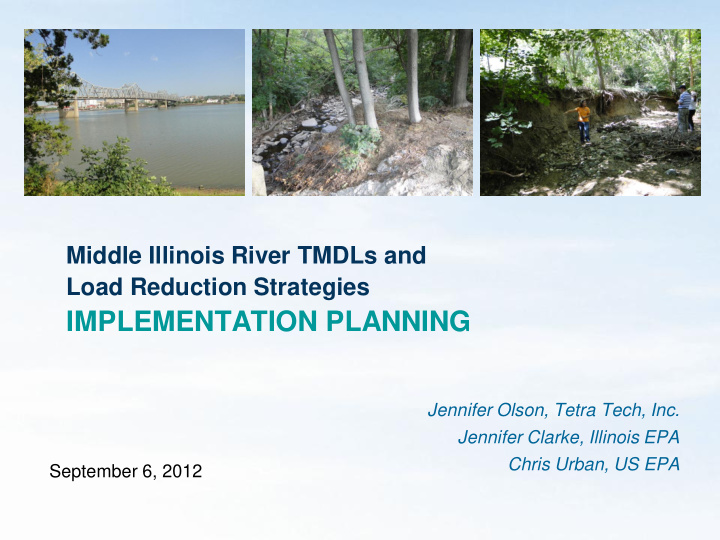



Middle Illinois River TMDLs and Load Reduction Strategies IMPLEMENTATION PLANNING Jennifer Olson, Tetra Tech, Inc. Jennifer Clarke, Illinois EPA Chris Urban, US EPA September 6, 2012
Presentation Overview ► Project Area ► TMDL Analysis and Conclusions ► Implementation Planning Process ► Pilot Areas ► Questions & Comments
Project Area ► 2,100 square mile Middle Illinois watershed River Watershed ► Illinois River Bluffs Region ► Many tributary Illinois River inputs Watershed ► Backwater lakes
Why are TMDLs and LRSs needed for the Middle Illinois River watershed? ► Streams/River/Lakes not meeting water quality goals Pathogens ( Fecal Coliform ) Chloride Manganese Total Dissolved Solids Phosphorus (lakes) Sediment Nutrients
► Three Impaired Main Stem Segments ► Three Impaired Tributaries Big Bureau Kickapoo Farm ► Two Impaired Lakes Depue Senachwine
TMDL Determined Pollutant Reduction Goals ► 75% reduction in ► 96% reduction in chloride in Farm TSS in Kickapoo Creek Creek ► Up to 79% ► Up to 39% reduction in fecal reduction in TSS in coliform in Illinois Illinois River River ► 20-90% reduction ► 9-68% reduction in in TP load TN load
Source Identification ► Wastewater (treatment plants, sewer overflows, septics) ► Industrial facilities ► Stormwater runoff (urban and agricultural) ► Erosion (bluffs, channel, gullies) ► Animal agriculture (stream access, AFOs)
TMDL and LRS Status ► Public comment period ended in February ► Final draft document available on Illinois EPA website http://www.epa.state.il.us/water/tmdl/report- status.html#ill ► Still subject to US EPA review and approval ► Implementation planning efforts underway Focus of this meeting
Implementation Approach ► Obtain input from stakeholders on needs and wants ► Develop a watershed approach that achieves objectives ► Provide focused implementation activities with costs and milestones General Implementation Plan BMP Optimization - Pilot Studies ► Work with local partners to review and finalize plan ► Use adaptive management process to revisit and refine plan in future
BMP Optimization Process Baseline Identify potential BMPs Identify watershed conditions opportunities Design and cost BMP modeling assumptions Evaluate options
Pilot Area Analysis ► Pilot area approach ► Two priority watersheds selected for focused Dry Run Tributary analysis Dry Run Tributary Creek watershed North Farm Creek North Farm Creek watershed ► Watershed and BMP modeling ► Implementation planning
Dry Run Tributary Creek ► 1,690 acres ► Peoria and Peoria Heights ► Tributary to Dry Run, Kickapoo Creek, and Illinois River ► Watershed is 94% developed Residential High School Commercial centers
Dry Run Tributary Creek ► High peak flows and volumes causing stream instability, erosion, pollutant loading ► Need reductions in bacteria, sediment, nutrients ► Sources are linked to urban stormwater runoff ► Previous work to evaluate channel and erosion issues
North Farm Creek Watershed ► 6,248 acres, East Peoria, Washington ► Steep slopes, ravines, and gullies common ► Watershed drains to Farm Creek and Illinois River
North Farm Creek Watershed ► Need reductions in sediment, nutrients, chloride ► Sources are linked to: Stormwater runoff Erosion Point sources Salt application
North Farm Creek Watershed ► Stormwater runoff is causing gully erosion, ravine formation, and other significant erosion issues ► Existing efforts – Steep Slope Ordinance
How Do We Solve the Problem? ► Non-structural practices ► Structural practices Street and parking lot Bioretention and rain sweeping gardens Ordinances Permeable pavement Education programs Filter strips and buffers Pollution prevention Rain barrels programs focused on pet Ponding waste and yard waste Others Winter road materials management Conservation/Revegetation Others
Finding the Right Balance for Implementation ► Need to identify both structural and non- structural improvements How much of each? Where? ► Transfer tools to local organizations for future use BMP modeling analysis for stormwater sources ► Evaluate costs and timing considerations
BMP Modeling Analysis ► Long-Term Hydrologic ► BMP Decision Support Impact Assessment System (BMPDSS) (L-THIA) Developed by Tetra Tech for Prince George’s Developed by Purdue County, Maryland Provides long-term annual An “add on” model averages (flow, pollutant Allows for optimization of loads) CN based runoff analysis BMPs Integrates costs with EMCs for water quality Evaluates BMPs using LID Models BMPs individually version using adjusted CN and as treatment train values Requires continuous Web-based, easily simulation model accessible Available from PG County High Level of Complexity Low
Next Steps ► Obtain input on pilot areas Watershed concerns Existing efforts Possible implementation activities ► Modeling analysis L-THIA, BMPDSS Pilot area implementation plans BMPs, costs, timing ► Update Middle Illinois River TMDL implementation strategy ► Timeline – Project completion Dec 2012
Questions/Comments
Recommend
More recommend